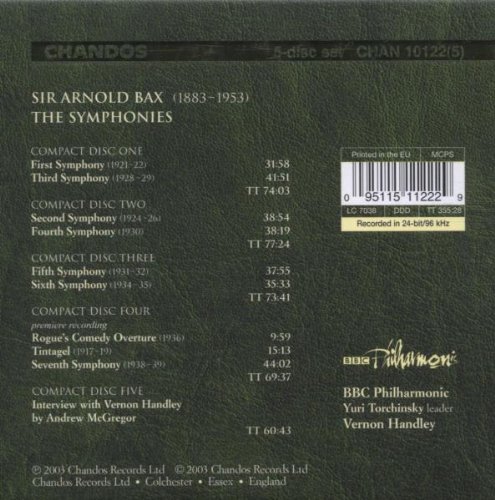All Categories



Get it between 2025-02-18 to 2025-02-25. Additional 3 business days for provincial shipping.
*Price and Stocks may change without prior notice
*Packaging of actual item may differ from photo shown
- Electrical items MAY be 110 volts.
- 7 Day Return Policy
- All products are genuine and original
- Cash On Delivery/Cash Upon Pickup Available








About Bax: The Symphonies
Amazon.com This 5-CD set includes all seven symphonies by Arnold Bax (1883-1953), the familiar tone poem Tintagel, and the Rogue's Comedy Overture in its premier recording. It also features Vernon Handley in two interviews--one with Lewis Foreman in the booklet, one with Andrew McGregor on the final disc. However, it's probably advisable to listen to it first, since Handley, one of Bax's most dedicated champions, has many illuminating things to say. Bax called himself "a brazen romantic....my music is the expression of emotional states." The symphonies, written between 1921 and 1939, certainly reflect both inner and outer events: the Irish Uprising, which deeply affected Bax, who loved Ireland and lost many friends to the "troubles," World War I and the looming threat of World War II. Perhaps the most striking and pervasive characteristic of the music is contrast. All the symphonies have three movements divided into many sections with different tempo indications, signaling changing mood and character. Indeed, moods change constantly, often abruptly and violently; dynamics surge and swell, climaxes build with increasingly ferocious power. The orchestration is masterful, creating color, texture, atmosphere and expression; at full throttle, the sound shakes the rafters. The music is predominantly serious, somber, dark, with outbursts of passion, turbulence, bitterness and anger, relieved by unexpectedly rambunctious and martial sections. Every symphony opens on low instruments, setting a dark, ominous mood, but several end with a triumphant flourish, while others fade away with an Epilogue in serenity or resignation. No. 7 is regarded as Bax's compositional farewell, No. 4 as "cheerful and blustery." The form is sometimes cyclical, with opening material returning in another guise, which, for the naked ear, is difficult to discern. Most memorable are the truly beautiful, luxuriously lyrical melodies that abound especially in the slow movements. The playing is first-rate throughout. --Edith Eisler




 (1)
(1)













